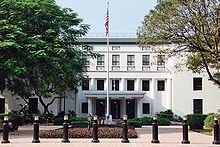Embassy of the United States, Manila

Multi tool use
Embassy of the United States in Manila | |
|---|---|
 | |
| Location | Ermita, Manila |
| Address | 1201 Roxas Boulevard Manila 1000, Philippines |
| Coordinates | 14°34′37″N 120°58′40″E / 14.57693°N 120.97770°E / 14.57693; 120.97770Coordinates: 14°34′37″N 120°58′40″E / 14.57693°N 120.97770°E / 14.57693; 120.97770 |
| Ambassador | Sung Kim |
The Embassy of the United States of America to the Philippines is situated in the Chancery Building of the Manila American Embassy along Roxas Boulevard (formerly Dewey Boulevard) in Ermita, Manila. The Embassy has been representing the United States Government since the Philippines was granted independence on July 4, 1946.
The Manila mission is one of the Department of State's largest posts, employing close to 300 Americans and 1,000 Foreign Service national employees. The mission also hosts the only foreign office of the Department of Veterans Affairs, which caters to some 18,000 American and Filipino veterans and their widows in the Philippines [1](see also Filipino Veterans Fairness Act.)
Manila's Regional Printing Center provides printing and distribution services for overseas and domestic publications. Smaller branches exist in Vienna, Austria and Washington, D.C. but Manila is the flagship facility.
Contents
1 History
2 Embassy sections
3 Staff
4 See also
5 References
6 External links
History
The chancery of the Embassy in Manila was first constructed to house the United States High Commission to the Philippines and was designed by the architect Juan M. Arellano. The building is built on reclaimed land that was a gift from the Government of the Philippines and sits on more than 600 reinforced concrete piles that were sunk 60 feet into the site. The site was originally designed as a demesne along Manila Bay, which featured a revival-style mansion that took advantage of the seaside vista. It was insisted, though, that a federal-style building be built.The Chancery was completed in 1940[2]
During World War II, after the Fall of Bataan, the property became the residence of the Commander-in-Chief of the Imperial Japanese Army in the Philippines. When the Japanese-sponsored Puppet Republic was established in 1943, the building was repainted and refurbished and served as the Embassy of Japan to the Philippines. During its recapture by Allied forces and Philippine guerrillas, the building was seriously damaged but its ballroom, among other rooms, remained intact.
In October 1945, quonset huts were erected throughout the property and became known as The Courthouse, the center of the Japanese war crimes trial in the Philippines, with the ballroom serving as the courtroom and the upstairs rooms serving as holding cells.
On July 4, 1946, the Philippines was granted independence by the United States and the building became known as the United States Embassy in Manila.
As a testament to its battle-scarred history, its flagpole was never restored and still retains the bulletholes it sustained during the war. The chancery has also been designated as historic property by the National Historical Institute of the Philippines as well as being on the United States Secretary of State's register of culturally significant places.
Embassy sections
The Embassy exercises a number of functions in its representation the Government of the Philippines, including political, administrative, economic, public diplomacy, and consular affairs, that are managed under the Ambassador by counselors from the U.S. Department of State.
For bilateral development projects, the managing office is the United States Agency for International Development, while military affairs are managed by Defense Attaché and the Joint U.S. Military Assistance Group in the Philippines. The Veterans Administration also has its only overseas office, and outpatient clinic, at the Embassy in Manila.[1]
- Consular Section
- American Citizen Services
- Visa Services
- Economic Section
- Defense Attaché
- Public Affairs
- Political Section
- Management Section
- Other U.S. Government Agencies
- U.S. Agency for International Development
- U.S. Ambassador to the Asian Development Bank
- U.S. Foreign Agricultural Services
- U.S. Commercial Service
- U.S. Peace Corps-Philippines
- Regional Printing Center-Manila
- Social Security Administration
- U.S. Department of Veterans Affairs
- International Broadcasting Bureau
- Joint U.S. Military Assistance Group
- Foreign Commercial Service Liaison Office to the Asian Development Bank
- U.S. Citizen and Immigration Services
There is also an American Consular Agent in Cebu as well as a virtual consulate in Davao City.
Staff
The current United States Ambassador to the Philippines is Sung Kim and the Deputy Chief of Mission is Michael Klecheski.
See also
The American Residence at Baguio City
- Embassy of the Philippines in Washington, D.C.
References
^ Alcazaren, Paulo (12 November 2005), "Juan M de Guzman Arellano : Renaissance Man", The Philippine Star.- THE SECRETARY OF STATE’S REGISTER OF CULTURALLY SIGNIFICANT PROPERTY
^ Ricciardone, C. (October 2002), "Post of the Month: Manila", State Magazine.
^ Jerry E. Esplanada (14 April 2011). "US Embassy opens veterans' office, clinic". Philippine Daily Inquirer. Archived from the original on 18 September 2013. Retrieved 4 March 2013..mw-parser-output cite.citation{font-style:inherit}.mw-parser-output q{quotes:"""""""'""'"}.mw-parser-output code.cs1-code{color:inherit;background:inherit;border:inherit;padding:inherit}.mw-parser-output .cs1-lock-free a{background:url("//upload.wikimedia.org/wikipedia/commons/thumb/6/65/Lock-green.svg/9px-Lock-green.svg.png")no-repeat;background-position:right .1em center}.mw-parser-output .cs1-lock-limited a,.mw-parser-output .cs1-lock-registration a{background:url("//upload.wikimedia.org/wikipedia/commons/thumb/d/d6/Lock-gray-alt-2.svg/9px-Lock-gray-alt-2.svg.png")no-repeat;background-position:right .1em center}.mw-parser-output .cs1-lock-subscription a{background:url("//upload.wikimedia.org/wikipedia/commons/thumb/a/aa/Lock-red-alt-2.svg/9px-Lock-red-alt-2.svg.png")no-repeat;background-position:right .1em center}.mw-parser-output .cs1-subscription,.mw-parser-output .cs1-registration{color:#555}.mw-parser-output .cs1-subscription span,.mw-parser-output .cs1-registration span{border-bottom:1px dotted;cursor:help}.mw-parser-output .cs1-hidden-error{display:none;font-size:100%}.mw-parser-output .cs1-visible-error{font-size:100%}.mw-parser-output .cs1-subscription,.mw-parser-output .cs1-registration,.mw-parser-output .cs1-format{font-size:95%}.mw-parser-output .cs1-kern-left,.mw-parser-output .cs1-kern-wl-left{padding-left:0.2em}.mw-parser-output .cs1-kern-right,.mw-parser-output .cs1-kern-wl-right{padding-right:0.2em}
External links
- Embassy of the United States in Manila website
Np9MyUNrV1 K,B5ZLp,F5NvhAQh